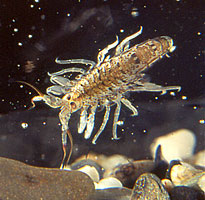 (©Carol & Mark Archambault)
(©Carol & Mark Archambault)
|
Amphipods Amphipods are small crustaceans that have narrow bodies with 8 legs and arched backs. The last 3 legs are modified for swimming and don't often look like legs. Their other legs vary in size and shape and they may have claws on some legs. They live in a variety of environments in estuaries, eating detritus and marine plants. The amphipods in the family Gammaridae are the most common group found in the rocky intertidal zone. Most species are olive green or brown and some have spots or bands. They can reach 0.9" (22 mm) in length but most are about 1/2" (13 mm) long. Amphipods in the family Talorchestia are semi-terrestrial, living on sandy beaches. There are two common species, the long-horned sandhopper and the big-eyed sandhopper. Both burrow into the sand and are whitish or sand colored. The big-eyed sandhopper lives near the high tide level and the long-horned sandhopper lives above the tide level, often found more than 330 feet (100 meters) inland. The big-eyed sandhopper is slightly smaller 0.9" (24 mm) than the long-horned sandhopper 1.1" (27 mm). |